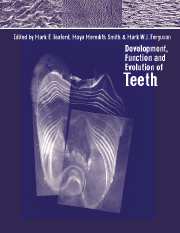Book contents
- Frontmatter
- Contents
- List of contributors
- Acknowledgements
- Part one Genes, molecules and tooth initiation
- 1 Homeobox genes in initiation and shape of teeth during development in mammalian embryos
- 2 Return of lost structure in the developmental control of tooth shape
- 3 Molecules implicated in odontoblast terminal differentiation and dentinogenesis
- 4 Enamel biomineralization: the assembly and disassembly of the protein extracellular organic matrix
- Part two Tooth tissues: development and evolution
- Part three Evolution of tooth shape and dentition
- Part four Macrostructure and function
- Index
2 - Return of lost structure in the developmental control of tooth shape
Published online by Cambridge University Press: 11 September 2009
- Frontmatter
- Contents
- List of contributors
- Acknowledgements
- Part one Genes, molecules and tooth initiation
- 1 Homeobox genes in initiation and shape of teeth during development in mammalian embryos
- 2 Return of lost structure in the developmental control of tooth shape
- 3 Molecules implicated in odontoblast terminal differentiation and dentinogenesis
- 4 Enamel biomineralization: the assembly and disassembly of the protein extracellular organic matrix
- Part two Tooth tissues: development and evolution
- Part three Evolution of tooth shape and dentition
- Part four Macrostructure and function
- Index
Summary
Introduction
Perhaps one of the main attractions, both scientifically and aesthetically, of mammalian teeth is their diversity. Among other things, differently shaped teeth are a good reminder of both evolutionary flexibility and precision of developmental control mechanisms. In this respect, mammalian teeth offer a good opportunity to use the fossil record to test our models of development. However, although the diversity of tooth shapes has been described in great detail and their evolutionary history has been relatively well reconstructed, our current knowledge of general mechanisms controlling tooth shape development is limited. As a first approximation, a great deal of mammalian molar tooth diversity derives from different combinations of cusps (Chapter 19). Cusp number, size and shape can vary from one tooth to the next and often cusps are connected by crests (lophs). Even this ‘gross tooth’ diversity constitutes a considerable challenge to a developmental biologist wishing to study the development of tooth shapes. Indeed, the list of students of comparative tooth development is extensive and extends back in time to Richard Owen (e.g. Owen, 1845; Leche, 1915; Bolk, 1920–22; Butler, 1956; Gaunt, 1961).
While the enthusiasm to study comparative ontogeny of different tooth shapes appears to have slowly declined, molecular studies of mouse tooth development have flourished (see Weiss, 1993; Thesleff et al., 1995; Thesleff and Sahlberg, 1996 for reviews). As a subject of study, the diversity of biological shapes has been transposed by the diversity of genes and their products. In practical terms this implies that, of total mammalian tooth diversity, we are left with the dentition of a mouse. This does not imply that mouse teeth are somehow uninteresting.
- Type
- Chapter
- Information
- Development, Function and Evolution of Teeth , pp. 13 - 21Publisher: Cambridge University PressPrint publication year: 2000
- 3
- Cited by



